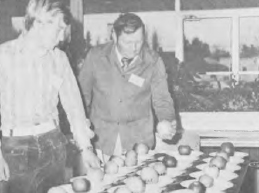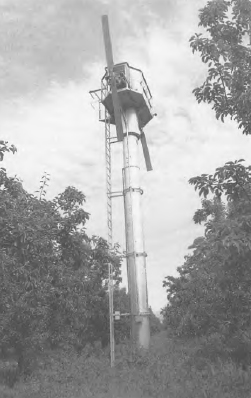News & Events More |
Boom and Bust: The Swing of the SixtiesFarmers never feel that prices for their produce are as high as they should be. But in the mid-1960s Okanagan apple growers were reasonably satisfied with conditions. A 1966 survey found that although most of them felt prices were too low, they overwhelmingly supported the existing systems for handling and selling fruit, and ninety per cent of those surveyed said that they received sustained enjoyment from fruit growing. They looked forward to expansion: over a quarter of them expected to increase the size of their operation over the next ten years, while less than ten per cent expected to be leaving the business (apart from reasons of retirement). Vignette: Spartan SolutionAt the 1964 B.C.F.G.A. Convention, a resolution originating from the directors of B.C. Tree Fruits offered an ingenious if slightly devious scheme to solve the problem of the poor reputation which the Spartan apple had acquired. The resolution proposed that since the name "Spartan" was a marketing liability, and consumer tests showed that the public bought eighty-five per cent more Spartans if they were offered as "McIntosh Royal" rather than under their own name, that the industry should adopt that as the new name for Spartans. As well as the movers, there were twenty speakers on the resolution, but it was defeated by the narrow margin of thirty-five votes to thirty-four. Expectations rose with the growth of returns. The net return for apples from the relatively short crop of 1967 almost doubled to 6.8 cents per pound from 3.5 cents the previous year. The 1968 return was even better: 7.2 cents per pound. In that period of economic boom, expectations, and therefore the assumptions behind investment and expansion, were for continuing growth in prices and returns. But it was not to be. Art Garrish recalled the crunch: The sixties by everybody's standards was a relatively affluent period. It came to an abrupt end for the fruit industry in the 1969-70 crop year. . . . The advances were made in the fall of 1969 until early December, but from that point on the money flow into the industry dried up and nothing came through to the growers. By February and March we had gone for quite some time with no sizable amount of money coming down to the packing house level to distribute to the growers. The three houses that existed in this end of the valley-Oliver-Osoyoos, Monashee and Haynessent a message out to their growers pointing out that we were aware of the situation but we had been unable to get any satisfactory explanation of what was going on. Clearly the growers were becoming very restless because they were used to having regular amounts of money sent out to them and nothing was coming. What had happened, of course, was that we had a sizable crop, the market had turned down, and competition from other areas had pretty well shut us out of our normal outlets. The money simply wasn't coming in. This was an unthinkable situation for an industry that had been doing very nicely for the last eight or ten years. Signs of what was to come appeared on May 13, 1970, when between a hundred and fifty and two hundred growers, mostly from the southern Okanagan, picketed the B.C. Tree Fruits offices in Kelowna. They were demanding more money and calling for, among other things, the same loosening of wholesale restrictions which the dissidents had wanted in 1956. They were unwilling to listen to Alan Claridge's explanation at a meeting at the Community Theatre that the money they wanted “had not gone down any devious road, but that it had simply not been available from the market". The eventual net return on apples from the 1969 crop was 3.4 cents per pound, less than half that from the previous crop, and the lowest for a decade. Prices the next year were little better, returning only 4 cents per pound on the 1970 crop. With production costs for apples averaging 3.15 cents per pound in 1970, these prices left little for the grower to put towards paying the interest he owed the banks or towards paying himself a wage to support himself and his family. Indeed, it was calculated that in 1970 apple growers sustained an average net loss of $96 per acre after the costs of operation, capital, and management. The abrupt change in conditions and outlook is clearly seen by comparing the slogan attached to the B.C.F.G.A. Convention in January of 1969-"Farming Today With Tomorrow in Mind"- with that for the 1971 Convention-"Challenge of Survival in the '70s". Two years later the slogan was "Unity is the Key in '73". Horticultural ForumDuring the 1960s, many B.C. growers attended the well-known Washington State Horticultural Meetings held annually in the first week of December, and interest grew in instituting something similar north of the border. The success of a Sweet Cherry Forum held at Kelowna in February, 1968, led to a resolution passed at the 1969 Convention for the establishment of regular horticultural forums under the sponsorship of the Association. A Horticultural Forum Committee of growers and professionals from the two departments of agriculture was established, with Hans Rhenisch of Keremeos as chairman. The first Horticultural Forum, held November 24 and 25, 1969, at the Penticton Peach Bowl, focussed on apples with a program that included, as well as local speakers, Dr. Heinicke and Dr. Tukey from Washington State. The good attendance of 538 Canadians and 61 Americans who registered, plus about a hundred and fifty who did not register, meant that the event reached a break even point financially. 
In following years the topics considered ranged through most of the horticultural concerns of fruit growers, from the trace element requirements of fruit trees to new Asian pear varieties. Attendance did not stay at the high levels of the first year-only 280 growers came in 1972-but it was sufficient to indicate the value of the Forums to the more progressive growers, and to ensure continuation. The Horticultural Forums are a combination of instructional seminars, trade shows, and social gatherings of growers, with presentation of awards of excellence and other similar events. The 1972 Forum, for example, presented programs on Soil Nutrition, the Economics of Survival, Pest Problems, and Trickle Irrigation and High Density Orchards. The Golden Apple Award for top apple orchard was presented to Alfred Kempf of Kelowna. Ken Wignes of Penticton won a $25 cash prize in the Apple Identification Competition by correctly naming nineteen of some forty-seven different apple varieties on display. Many growers, especially those who had borrowed heavily to finance new machinery and orchard replanting, or to buy acreage at rapidly rising land prices which urban pressure had caused, found themselves in extreme difficulties. By 1972, fourteen per cent of Farm Credit Corporation loans to Okanagan orchardists were in arrears, and even the very gradual recovery of fruit prices after 1970 was not sufficient to pull them out of their difficulties. By 1973 when Dr. S.C. Hudson investigated the state of the industry, he concluded that only a third of growers were able to cover operational costs and provide a reasonable return for capital and management. Another third could manage to cover current operating costs but no more, while the final third "are having difficulty in covering even their essential operating expenses from their returns and have had to lower their level of family living and in some cases increase their indebtedness." Growers in financial difficulties were ready to look for a scapegoat to blame for low returns and to try alternative methods to sell their fruit. Independent investigation proved that B.C. Tree Fruits had provided and was still providing better returns to growers than comparable marketing organizations in the U.S. and Ontario, and that an equally satisfactory job could not have been done without the central marketing system which had been built up over a period of years in British Columbia." But such facts were simply irrelevant to the grower who knew only that he was unable to meet his expenses. Some small part of the agitation against B.C. Tree Fruits and the efforts to evade the marketing monopoly may have come from those growers who were philosophically opposed to the principles of cooperation and central selling. But most of it was simply the action of people desperate for cash who therefore had to look for any way to get the greatest return from their fruit in the short term, even if it meant undermining the organization and the returns of the industry as a whole. And few of the growers had been in the industry long enough to recall the chaos that cut-throat competition had created in the years before the Second World War. 
The Association increased its efforts to get government assistance and to improve marketing conditions. In April, 1971, the B.C.F.G.A. even staged a demonstration of its own. About fortyfive growers, including the Executive, picketed ships delivering Australian apples at the port of Vancouver. They handed out B.C. apples and brochures complaining of the Australian refusal to allow a return trade of Canadian fruit. "They were quite prepared to export apples into Canada, but they could always find some phytosanitary reason not to take ours." The demonstration generated favourable publicity, but no immediate results. Efforts to get government assistance were similarly disappointing. After long negotiations and representations, the Association's request to Ottawa for aid to alleviate the 1969 financial disaster was "finally terminated in an unsatisfactory manner" with the payment of $379,904 for apple concentrate in 1971 by the Agricultural Products Board. The B.C.F.G.A.'s original request had been for approximately $3.2 million. Tough times led to renewed assaults on the way in which B.C. Tree Fruits did business, and revival of the old dissident ideas. No fewer than four resolutions calling for the establishment of industry-owned retail fruit markets in western Canadian cities, all from the southern areas, were put to the 1971 B.C.F.G.A. Convention. All were defeated, but another one did pass which called on B.C. Tree Fruits to expand its selling policy to include any properly licensed dealer where markets were not properly serviced by established channels or where those established channels were taking excessive markups. The following year, in 1972, the perennial Oliver resolution on completely opening up the wholesale list was once again defeated, but a resolution to cooperate with government in establishing farmers' markets in the cities was passed. By 1973, B.C. Tree Fruits was, at the urging of the provincial government, developing a two-price system to serve fruit stands, hotels, and so on. Adaptation of the system was beginning to take place-but too slowly for the dissatisfied. Contact Us Hours: 9am - 4pm weekdays. t: 250-762-5226 |

